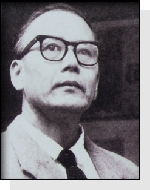- Park In- hwan (1926~1956)
- Park Su- geun (1914~1965)
- Kim Yu- jeong (1908~1937)
- Lee Hyo- seok (pen name Gasan) (1907~1942)
- Kim Dong- myeong (Choheo) (1901~1968)
- Han Yong- un (Buddhist name Manhae) (1897~1944)
- Namgung Eok (pen name Hanseo) (1863~1939)
- Yun Hui- sun (1860~1935)
- Yu In- seok (pen name Uiam) (1842~1915)
- Kim Byeong- yeon (pen name Nango) (1807~1863)
- Nam Gu- man (pen name Yakcheon) (1629~1711)
- Heo Mok (pen name Misu) (1595~1682)
- Heo Gyun (pen name Gyosan) (1569~1618)
- Heo Cho- hui (pen name Nanseolheon) (1563~1589)
- Sinsaimdang (1504~1551)
- Kim Si- seup (pen name Maewoldang) (1434~1493)
- Won Cheon- seok (pen name Ungok) (1330~ ?)
- Lee Seung- hyu (pen name Dongangeosa) (1224~1300)
Park Su-geun (1914~1965)

A painter hailing from Yanggu, he graduated from Yanggu Public Elementary School, and then taught himself painting.
In 1932, he made his debut in painting circles when his work ‘Spring is’Gone’ was selected for the 11th Seonjeon painting contest. He was selected a total of eight times in the contest until 1944. While living in Changsin-dong, Seoul, during the Korean War (evading the war, he painted portraits at the U. S. Armed Forces Base. He participated in the 2nd National Art Exhibition held in 1953, and won the top prize.
Afterwards, he worked as a full-time painter, and won prizes in contests on ten occasions. In 1959, he became a painter recommended by the National Art Exhibition. In 1962, he served on the 11th National Art Exhibition Screening Committee, and entered the Manila International Art Exhibition.
In 1963, he lost the eyesight of one of his eyes due to a cataract, and died of liver cirrhosis at 52 in 1965. He struggled with poverty and lonesomeness, only to die without receiving the spotlight. However, in 1980, he was posthumously awarded the Eun-gwan (silver crown) of the Order of Culture Merit. He was more famous after he died than while alive. He uses mainly gray and white simple lines and materials in his works, and expresses monotonous surrounding scenery in our lives with simple and sensible touches. Thus, his works are full of fresh life. His major works include: ‘Woman Pounding a’Mortar’ (1925), ‘Washing’Place’ (1954), ‘Rest’ (1959), ‘On the ’Road’ (1962), ‘Home’Coming’ (1962), ‘Woman’Working’ (1962), ‘Old Tree and’Woman’ (1964) and so on.
In 1932, he made his debut in painting circles when his work ‘Spring is’Gone’ was selected for the 11th Seonjeon painting contest. He was selected a total of eight times in the contest until 1944. While living in Changsin-dong, Seoul, during the Korean War (evading the war, he painted portraits at the U. S. Armed Forces Base. He participated in the 2nd National Art Exhibition held in 1953, and won the top prize.
Afterwards, he worked as a full-time painter, and won prizes in contests on ten occasions. In 1959, he became a painter recommended by the National Art Exhibition. In 1962, he served on the 11th National Art Exhibition Screening Committee, and entered the Manila International Art Exhibition.
In 1963, he lost the eyesight of one of his eyes due to a cataract, and died of liver cirrhosis at 52 in 1965. He struggled with poverty and lonesomeness, only to die without receiving the spotlight. However, in 1980, he was posthumously awarded the Eun-gwan (silver crown) of the Order of Culture Merit. He was more famous after he died than while alive. He uses mainly gray and white simple lines and materials in his works, and expresses monotonous surrounding scenery in our lives with simple and sensible touches. Thus, his works are full of fresh life. His major works include: ‘Woman Pounding a’Mortar’ (1925), ‘Washing’Place’ (1954), ‘Rest’ (1959), ‘On the ’Road’ (1962), ‘Home’Coming’ (1962), ‘Woman’Working’ (1962), ‘Old Tree and’Woman’ (1964) and so on.
최근 업데이트 2023-01-10


